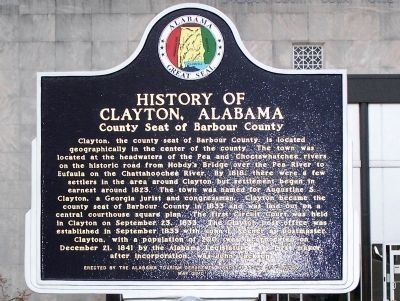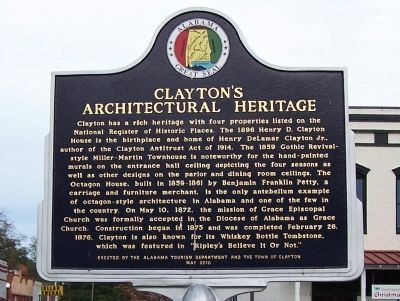Clayton in Barbour County, Alabama — The American South (East South Central)
History of Clayton, Alabama/Clayton’s Architectural Heritage
County Seat of Barbour County
Clayton, the county seat of Barbour County, is located geographically in the center of the county. The town was located at the headwaters of the Pea and Choctawhatchee rivers on the historic road from Hobdy’s Bridge over the Pea River to Eufaula on the Chattahoochee River. By 1818 there were a few settlers in the area around Clayton but settlement began in earnest around 1823. The town was named for Augustine S. Clayton, a Georgia jurist and congressman. Clayton became the county seat of Barbour County in 1833 and was laid out on a central courthouse square plan. The first Circuit Court was held in Clayton on September 23, 1833. The Clayton post office was established in September 1835 with John F. Keener as postmaster. Clayton, with a population of 200, was incorporated on December 21, 1841 by the Alabama Legislature. Its first mayor, after incorporation, was John Jackson.
Reverse:
Clayton’s Architectural Heritage
Clayton has a rich heritage with four properties listed on the National Register of Historic Places. The Henry D. Clayton House is the birthplace of Henry DeLamar Clayton Jr., author of the Clayton Antitrust Act of 1914. The 1859 Gothic Revival-style Miller-Martin Townhouse is noteworthy for the hand-painted murals on the entrance hall ceiling depicting the four seasons as well as other designs on the parlor and dining room ceilings. The Octagon House, built in 1859-1861 by Benjamin Franklin Petty, a carriage and furniture merchant, is the only antebellum example of octagon-style architecture in Alabama and one of the few in the country. On May 10, 1872, the mission of Grace Episcopal Church was formally accepted in the Diocese of Alabama as Grace Church. Construction began in 1875 and was completed February 26, 1876. Clayton is also known for its Whiskey Bottle Tombstone, which was featured in “Ripley’s Believe It Or Not.”
Erected 2010 by Alabama Tourism Department, and the Town of Clayton.
Topics. This historical marker is listed in this topic list: Settlements & Settlers. A significant historical date for this entry is February 26, 1869.
Location. 31° 52.685′ N, 85° 26.97′ W. Marker is in Clayton, Alabama, in Barbour County. Marker is on Court Street, on the left when traveling south. Touch for map. Marker is in this post office area: Clayton AL 36016, United States of America. Touch for directions.
Other nearby markers. At least 8 other markers are within walking distance of this marker. Comrades (here, next to this marker); Jere Locke Beasley (within shouting distance of this marker); Barbour County / Early Barbour County Commissioners (within shouting distance of this marker); Octagon House (about 300 feet away, measured in a direct line); Grace Episcopal Church (about 300 feet away); In Loving Memory of the Clayton Soldiers of the World War (approx. 0.2 miles away); Miller – Martin Townhouse (approx. ¼ mile away); Davis-Wallace House (approx. 0.3 miles away). Touch for a list and map of all markers in Clayton.
Credits. This page was last revised on November 30, 2021. It was originally submitted on November 1, 2012, by David J Gaines of Pinson, Alabama. This page has been viewed 1,549 times since then and 82 times this year. Photos: 1, 2. submitted on November 1, 2012, by David J Gaines of Pinson, Alabama. • Craig Swain was the editor who published this page.
Editor’s want-list for this marker. A wide view photo of the marker and the surrounding area together in context. • Can you help?

